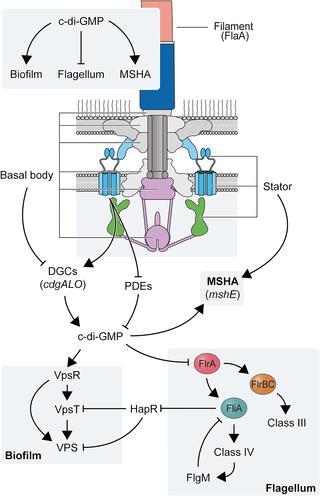PLOS Genetics ( IF 4.5 ) Pub Date : 2020-03-16 , DOI: 10.1371/journal.pgen.1008703 Daniel C Wu 1 , David Zamorano-Sánchez 1 , Fernando A Pagliai 1 , Jin Hwan Park 1 , Kyle A Floyd 1 , Calvin K Lee 2 , Giordan Kitts 1 , Christopher B Rose 1 , Eric M Bilotta 2 , Gerard C L Wong 2, 3, 4 , Fitnat H Yildiz 1

|
The assembly status of the V. cholerae flagellum regulates biofilm formation, suggesting that the bacterium senses a lack of movement to commit to a sessile lifestyle. Motility and biofilm formation are inversely regulated by the second messenger molecule cyclic dimeric guanosine monophosphate (c-di-GMP). Therefore, we sought to define the flagellum-associated c-di-GMP-mediated signaling pathways that regulate the transition from a motile to a sessile state. Here we report that elimination of the flagellum, via loss of the FlaA flagellin, results in a flagellum-dependent biofilm regulatory (FDBR) response, which elevates cellular c-di-GMP levels, increases biofilm gene expression, and enhances biofilm formation. The strength of the FDBR response is linked with status of the flagellar stator: it can be reversed by deletion of the T ring component MotX, and reduced by mutations altering either the Na+ binding ability of the stator or the Na+ motive force. Absence of the stator also results in reduction of mannose-sensitive hemagglutinin (MSHA) pilus levels on the cell surface, suggesting interconnectivity of signal transduction pathways involved in biofilm formation. Strains lacking flagellar rotor components similarly launched an FDBR response, however this was independent of the status of assembly of the flagellar stator. We found that the FDBR response requires at least three specific diguanylate cyclases that contribute to increased c-di-GMP levels, and propose that activation of biofilm formation during this response relies on c-di-GMP-dependent activation of positive regulators of biofilm production. Together our results dissect how flagellum assembly activates c-di-GMP signaling circuits, and how V. cholerae utilizes these signals to transition from a motile to a sessile state.
中文翻译:

相互的c-di-GMP信号传导:鞭毛生物发生不完全会触发促进生物膜形成的c-di-GMP信号传导途径。
V的装配状态。霍乱鞭毛调节生物膜的形成,表明该细菌感觉缺乏运动以保持无柄的生活方式。第二信使分子环状二聚鸟苷单磷酸酯(c-di-GMP)反向调节了运动性和生物膜形成。因此,我们试图定义鞭毛相关的c-di-GMP介导的信号通路,调节从运动状态到无柄状态的转变。在这里,我们报告说,通过丢失FlaA鞭毛蛋白而消除鞭毛,会导致鞭毛依赖性生物膜调节(FDBR)反应,从而提高细胞c-di-GMP的水平,增加生物膜基因的表达,并增强生物膜的形成。FDBR响应的强度与鞭毛定子的状态有关:可以通过删除T环成分MotX来逆转,+结合定子或钠的能力+动力。定子的缺失还导致细胞表面甘露糖敏感的血凝素(MSHA)菌毛水平降低,表明参与生物膜形成的信号转导途径的相互联系。缺乏鞭毛转子组件的菌株同样会发出FDBR响应,但这与鞭毛定子的组装状态无关。我们发现FDBR反应需要至少三个特定的双鸟苷酸环化酶,这些酶有助于增加c-di-GMP的水平,并提出在此反应过程中生物膜形成的激活依赖于c-di-GMP依赖性的生物膜生产阳性调节剂的激活。 。我们的研究结果共同剖析了鞭毛组装如何激活c-di-GMP信号传导回路以及V的方式。霍乱 利用这些信号从运动状态转变为静止状态。



























 京公网安备 11010802027423号
京公网安备 11010802027423号